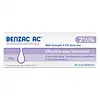What's inside
What's inside
 Key Ingredients
Key Ingredients

 Benefits
Benefits

 Concerns
Concerns

 Ingredients Side-by-side
Ingredients Side-by-side

Water
Skin ConditioningPotassium Azeloyl Diglycinate
Skin ConditioningEthoxydiglycol
HumectantNiacinamide
SmoothingGlycerin
HumectantSodium Polyacrylate
AbsorbentArachidyl Alcohol
EmollientBehenyl Alcohol
EmollientArachidyl Glucoside
Emulsifying4-Butylresorcinol
AntioxidantAlpha-Arbutin
AntioxidantGlycyrrhiza Glabra Root Extract
BleachingTocopheryl Acetate
AntioxidantDiethylhexyl Syringylidenemalonate
Skin ProtectingCaprylic/Capric Triglyceride
MaskingMethyl Methacrylate Crosspolymer
Disodium EDTA
BHA
AntioxidantBHT
AntioxidantMethylisothiazolinone
PreservativePhenoxyethanol
PreservativeParfum
MaskingWater, Potassium Azeloyl Diglycinate, Ethoxydiglycol, Niacinamide, Glycerin, Sodium Polyacrylate, Arachidyl Alcohol, Behenyl Alcohol, Arachidyl Glucoside, 4-Butylresorcinol, Alpha-Arbutin, Glycyrrhiza Glabra Root Extract, Tocopheryl Acetate, Diethylhexyl Syringylidenemalonate, Caprylic/Capric Triglyceride, Methyl Methacrylate Crosspolymer, Disodium EDTA, BHA, BHT, Methylisothiazolinone, Phenoxyethanol, Parfum
Ingredients Explained
These ingredients are found in both products.
Ingredients higher up in an ingredient list are typically present in a larger amount.
Disodium EDTA plays a role in making products more stable by aiding other preservatives.
It is a chelating agent, meaning it neutralizes metal ions that may be found in a product.
Disodium EDTA is a salt of edetic acid and is found to be safe in cosmetic ingredients.
Learn more about Disodium EDTAGlycerin is already naturally found in your skin. It helps moisturize and protect your skin.
A study from 2016 found glycerin to be more effective as a humectant than AHAs and hyaluronic acid.
As a humectant, it helps the skin stay hydrated by pulling moisture to your skin. The low molecular weight of glycerin allows it to pull moisture into the deeper layers of your skin.
Hydrated skin improves your skin barrier; Your skin barrier helps protect against irritants and bacteria.
Glycerin has also been found to have antimicrobial and antiviral properties. Due to these properties, glycerin is often used in wound and burn treatments.
In cosmetics, glycerin is usually derived from plants such as soybean or palm. However, it can also be sourced from animals, such as tallow or animal fat.
This ingredient is organic, colorless, odorless, and non-toxic.
Glycerin is the name for this ingredient in American English. British English uses Glycerol/Glycerine.
Learn more about Glycerin